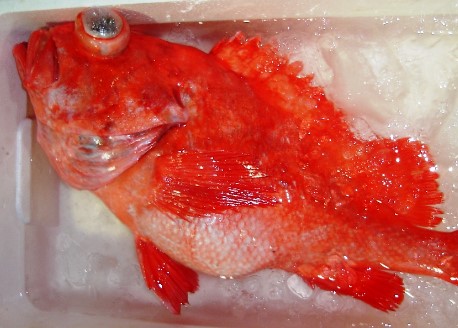
The appearance of Angry rockfish (Oosaga)
Common name: Angry rockfish
Japanese name: Oosaga (大佐賀、大逆)
Russian common name: Вспыльчивый морской окунь
Scientific name: Sebastes iracundus (Jordan and Starks, 1904)
Nigiri sushi detail: Angry rockfish (Oosaga) Nigiri sushi

The appearance of Angry rockfish (Oosaga) nigiri
Characteristics:
Angry rockfish (Oosaga) is distributed along the Pacific coast north of Choshi, the Kuril Islands, and the Emperor Kaiyamas. It inhabits rocky reef areas at depths of 200 to 1000 m. It feeds on crustaceans such as krill, fish, and squid. Its body is oval-shaped. The body length is 50~60 cm. Its body color is bright red, and a large black patch may be seen on the upper side of the body. It is caught by towing nets and fishing, but in extremely small quantities.
Generally, Angry rockfish (Oosaga), Coral rockfish (Sankomenuke), Brickred rockfish (Baramenuke), and Pacific Ocean perch (Arasukamenuke) are included in the Menuke group.
Oosaga has a light peach-colored flesh with a good amount of fat, and is a superb fish to eat as sashimi, simmered, grilled, or cooked in a pot, with almost nothing left to throw away. The gelatinous material between the skin and the meat is delicious, so kawashimo or aburi (searing) is best for sashimi.
Oboro is an essential part of Edomae Sushi, and is used in Japanese halfbeak (Sayori), Japanese whiting (Kisu) Nigiri, or in Chirashizushi. Oosaga was a typical ingredient. Now it has become a top-rated sushi topping. The fat of this fish has a sweetness that goes very well with sushi rice.
Today it is a luxury fish, but around 1901 it was used to make fertilizer, as was Broadbanded thornyhead (Kichiji).